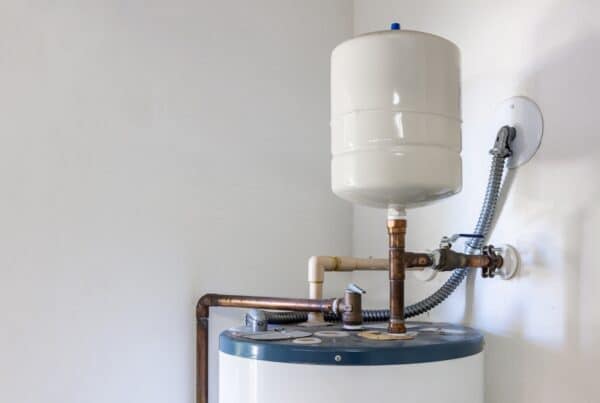
A dishwasher is a blessing to have in a home. It means less that we have to wash by hand when the dishes pile up in the sink. Also, modern dishwashers have so many functions, including water saving options! Have you ever wondered if dishwashers heat the water? The answer is yes! The sensors that are built in the dishwasher will tell it when the water level has reached its capacity. Then the heating elements will heat the water up to 130-140 degrees Fahrenheit.
Let’s take a look at the history of dishwashers, how they work, and how they are hooked up in the home. Also, we will look at maintenance of the dishwasher so yours will last a long time.
Dishwashers
Do you know the history behind the dishwasher? It was invented by Joel Houghton in 1850 and was a wooden box that used a wheel that had to be turned and it splashed water on dirty dishes. It also had scrubbers. Dishwashers were designed to make life easier for the busy family by allowing the household to run all of the dishes at once, and not handwash each dish.
The good news is they last about 6-10 years and are easy to take care of. Since the dishwasher also heats the water inside of it, it kills bacteria on the contents inside of it. The dishwasher also allows us to serve food and drink on clean dishes to our family with no worry about contamination.

How a Dishwasher Functions
A dishwasher is programmed to do so many things like a robot. The basic functionality of a dishwasher includes:
- It adds the water to be used in the cycle
- Always heats the water to the appropriate temperature
- Can automatically open the detergent dispenser at the right time
- High pressure shoots the water through jets to get the dishes clean
- Has a drain for the dirty water
- Follows up with spraying of more water on the dishes to rinse them
- Can drain itself again
- Will heat the air to dry the dishes off, if the user has selected that setting
Sensors and Timers in a Dishwasher
In addition to these features of your dishwasher, they are also capable of monitoring their own functionality. There are timers built into the dishwasher so that it knows how long each cycle will work for. There are also multiple sensors in the dishwasher that can adjust the temperature of the water to ensure that the dishes are not damaged and cleaned properly.
Another sensor in the dishwasher to ensure that the water level does not get too high and can be drained before over-flowing outside of the dishwasher pan. The last sensor in some dishwashers will monitor the water for how dirty it might be. This will tell the dishwasher when the dishes are clean and the cycle is over.
The Hookup of the Dishwasher
Your dishwasher is commonly hooked up to the hot water line that also connects to your sink. It consists of two valves. One is for the sink and the other is for the dishwasher. It is important that it is hooked up correctly. If you are unsure, contact a professional for help.
Flexible Copper Tubing Keeps the Water Hot
The piping that is installed to connect your dishwasher to the hot water valve is a flexible copper tubing. It is commonly used as it is a great insulator and keeps the water hot throughout. Ferrules and compression fittings are used for installing this flexible piping so that no leaks are present.

The Location of the Dishwasher
Typically, your dishwasher would be located next to the kitchen sink. This makes the hookup of the hot water hose an easier transition. Some homes will have the dishwasher located in another spot in the kitchen. As long as the plumbing allows for the hot water to be connected, this is not an issue.
High Loop
Often, the dishwasher will come with a hose that is 6 feet in length but can be made to reach up to 10-12 feet with attachments. However, sometimes it is too long depending on the space you have from your sink to your dishwasher. If you want to shorten it, you can make a high loop and this is easier than putting in an air gap (if your state allows it). Also, if you have a septic, you need to use a high loop.
Here is an explanation of high loop:
Air gap
An air gap is fitting that is installed on top of the sink to allow the hose to pass through to the drain. It provides a space in the line to keep the dirty water from the drain from going back into the dishwasher and contaminating the dishes. It can be hooked up to the drain line or to the garbage disposal. Every state has a rule about which one they require in the home so you need to research the requirements.
Keeping the Water Hot in the Dishwasher
After you have loaded the dishwasher and are ready to start the dishwasher, it is recommended that you run hot water into the sink. This will bring hotter water to your dishwasher and ensure that the dishes are cleaned with better results. Remember, when the water sits in the pipes due to inactivity, the water will cool. It takes the dishwasher more time to heat up the water unless you have already run the hot water into the sink from your faucet.

The Dishwasher Cycle
The best part about a dishwasher is that the water fills up in the bottom pan, but will not over flow. As mentioned earlier, the sensors that are built in will tell the dishwasher when the water level has reached its capacity. Then the heating elements will heat the water up to 130-140 degrees Fahrenheit.
After the water is heated to the maximum temperature, the pump in the dishwasher will force the water into the jets, and begin spraying the dishes through the top and bottom sprayers. Imagine what you see when your garden hose sprays the plants or sidewalk of your home. This is the same concept that the dishwasher uses to clean the dishes. The pressure of the hot water in the dishwasher forces the arms of the spray jets to rotate and connect with the dishes.
After the spraying is done, the dishes are rinsed and then the basin empties in to the dishwasher. The last part of the dishwasher cycle includes the heating elements. The heating elements will heat the air inside of the dishwasher and this dries your dishes. You may also choose to skip this portion of the dishwasher cycle and save energy by drying the dishes on your own.

Maintenance of the Dishwasher and Other Areas
Just like with all appliances, a dishwasher needs to be maintained. Here are a few things that you can do:
- Change Out the Filter. Just like an air conditioning unit has a filter, so does the dishwasher. Many people do not know this! Sometimes the dishwasher drain will clog, leaving food at the bottom. The first thing to do when this happens is change out the dishwasher filter.
- Garbage Disposal (unless you have a septic) – the garbage disposal and the dishwasher are connected together. This is why when you hear the dishwasher running, there is often water noises or a light gurgling sound in the sink. You want to make sure you are performing good maintenance on the garbage disposal so this will hopefully help the dishwasher run well for a long time. If you have a septic, don’t use the garbage disposal. The grease and fats from food can harm the system so put the left over food in the garbage.
The garbage disposal also needs maintenance by doing a few things so they last 10-15 years. Some of those things are: running water when using it and keeping oil and grease out of the disposal as well as stringy vegetables to name a few.

3. Maintain the Hot Water Heater – since the water needs to be able to heat up in the unit, it is important to make sure the hot water heater is working. It sends the warmer water to the sink that you turn on to warm up the water before running the dishwasher. The maintenance tips are to flush the water heater, adjust the temperature and reset, and turn the water heater off and back on to name a few.

When to Call a Professional
You may need a professional if you have a dishwasher delivered and not sure how to hook it up. Also, if you have any issues with the unit and can’t figure it out you may need to call a professional. Often it is wise to consult the manual that came with the dishwasher to see if your questions can be solved.
Conclusion
Dishwashers have a sensing unit that heats the water up. Don’t forget to run the dishwasher when water is not being used in the home (such as the nighttime showers in the bathrooms). Additionally, turn on the hot water from the sink to get a jump start on the water heating. Alpha building inspectors can check the water lines in the home and the hot water heater when conducting a home inspection in Merrimack, New Hampshire, and surrounding areas.



